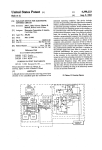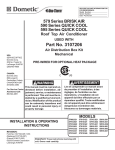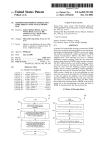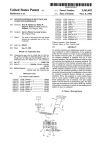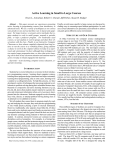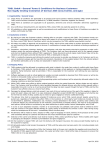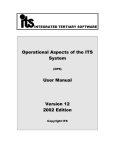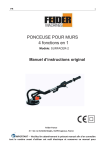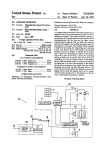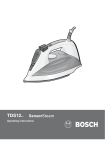Download Teletext decoders
Transcript
United States Patent [191 [11] Patent Number; Bugg et a1. [45] [54] TELETEXT DECODERS [75] Inventors: Richard E. F. Bugg, Coulsdon; David R. Tarrant, Sutton, both of England [73] Assignee: U.S. Philips Corporation, New York, NY. Controlled Teletext: User’s Manual”, by Kinghom; 11/1/83. Primary Examiner-John W. Shepperd Assistant Examiner-Michael D. Parker Attorney, Agent, or Firm-Thomas A. Briody; Jack E. [57] Foreign Application Priority Data , May 27, 1988 [GB] May 5, 1989 [GB] Mar. 20, 1990 Haken; William Squire [21] Appl. No.: 356,032 [22] Filed: May 23, 1989 [30] Date of Patent: 4,910,595 United Kingdom ............ .. 88125927 United Kingdom ............ .. 8910338.6 ABSTRACT A teletext decoder is provided with a page memory having rows (R0 to R73) for storing corresponding packets of teletext data, the page memory being pro [51] Int. Cl.4 ........................................... .. H04N 7/087 vided with at least one extra memory bit (F1, F2) for [52] [58] U.S., Cl. ............................... .. 358/147; 358/142 Field of Search .............. .. 358/141, 142, 146, 147 each row thereof, the extra memory bits constituting [56] U.S. PATENT DOCUMENTS 4,719,510 1/1988 ?ags (F1, F2) which may be selectively set by the pro cessor software in order to initiate selective action in References Cited Kinghorn .......................... .. 358/142 respect of those packets which correspond to the ?agged rows. The selective action might be to permit or prevent packets being written into memory or to alert the processor that immediate processing of a flagged OTHER PUBLICATIONS Data Sheet for SAA9040; “Computer Controlled Tele text Extension” by Mullard; Mar. 1986; pp. 593~602. packet is required. Mullard Application Laboratory; Mitcham; “Computer 18 Claims, 5 Drawing Sheets vmro [PROCESSOR "25‘ vs vs’ —L~ l vcs ( 1 INTERFACE (‘0:1. comm (pnocssson KEYFAD Ill] Um AMISl'TMq “D l “C US. Patent Mar. 20, 1990 Sheet 1 0f 5 VIDEO FRONT [ END vs 4,910,595 [PROCESSOR 1 vs’ vcs INTERFACE “D “c /' Ccf. CONTROL ( PROCESSOR DATA ACQUISITION/1 Cc’r. 2 2 n i 5 1’ 0/0 - [KEYPAD I 7 L -k 2 ‘ t3 j (PAGE) MEMORY E —T t3 :2 Q p p 8 (‘TIMING FIG.1 n 12 vcs ._S_ US. Patent Mar. 20, 1990 Lg . F V__ _ _ _(P)_o _ _ Sheet 2 of5 4,910,595 4° _ _ _ _ _ _ _ _ _ _ _ _Ro q“- ' US. Patent Mar. 20, 1990 NWT” """""" II'II Sheet 0f5 _ 4,910,595 T I US. Patent 'Mar.20, 1990 QL Sheet 4 (is. 4,910,595 1 4,910,595 2 In addition there are 384 packets which can be used TELETEXT DECODERS to described magazine or channel parameters. They do not form part of a teletext page, i.e. their reception does This invention relates principally to a teletext de not require a page header to have been previously cap coder for teletext information which consists of a plu 5 tured. They can be considered as stand-alone packets and are stored in a particular part of the teletext decoder rality of different pages each of which is identi?ed by a memory. respective page number and each of which comprises a plurality of data packets, said teletext decoder including processor means, means for selecting a page by its page number, means for detecting a selected page number Although the aforementioned “World System Tele text and Data Broadcasting System-Technical Speci? cation” allows for all the above mentioned packets and when received, and at least one page memory for stor a teletext decoder can be designed to capture them all, ing each received data packet of a selected page, said page memory comprising a plurality of rows for storing corresponding data packets of said selected page. The in practice, only sub-sets of all possible packets are actually transmitted. This determines the quantity of teletext transmissions in the UnitedvKingdom now use at least six television lines in each VBI as data-lines. The decoder processor is required to commence the process ing of the extension packet as soon as it has been re memory that should be reserved in memory for the invention also relates to a method of processing teletext 15 storage of one teletext page (including the extension packets). For example, in Germany only packets 0-23 information. are in current use; in UK. packets 0-23 and 24, 27 and The document “Broadcast Teletext Speci?cation”, 30 are in current- use and in Spain packets 0-23 and September 1976, published jointly by British Broadcast ing Corporation, Independent Broadcasting Authority packet 26 are in current use. Whilst it is desirable to design a single teletext decoder that satis?es the require and British Radio Equipment Manufacturers’ Associa ments of all possible markets, it should, at the same time, tion, discloses a speci?cation for transmitting teletext be capable of optimum performance in each market. information in 625-line television systems. In order to permit the capture of all possible packets, Proposals for enhancing the teletext speci?cation the page memory of a teletext decoder needs to be given in the said “Broadcast Teletext Speci?cation” are given in the document “World System Teletext and 25 provided with 74 “rows” each of 40 bytes. If such a decoder was used at the present time in Germany, then Data Broadcasting System- Technical Speci?cation”, only rows 0-23 of the page memory would be used and December 1987, compiled by the Department of Trade the remainder (two-thirds) of the memory would never and Industry of the UK. Government. be used since no extension packets are currently trans The teletext information is usually transmitted as part 30 mitted in Germany. Thus two-thirds of the memory ofthe television signal in television lines where no nor capacity is wasted. mal television picture information is present. Initially, It is one object of the present invention to provide a teletext transmissions in the United Kingdom used as teletext decoder which enables an under-used page teletext data lines television lines 17 and 18 in ?rst ?elds memory to be more efficiently used. and television lines 330 and 331 in second ?elds of the Another problem which can exist in present day tele ?eld or vertical blanking intervals (V BI), but current text decoders, is that for certain extension packets the VBI transmission is thus, in effect, multiplexed with the normal picture transmission and the teletext information transmitted in this way and representing data for display such as text and graphics can be displayed at a teletext television receiver as a selectable alternative to the normal picture information. ceived. For example, a packet 27 contains the page 40 numbers to be associated with coloured buttons pro vided on a texttelevision remote control for a teletext receiver which is provided with so-called “Fastext”. One of these pages may be the next page to be transmit ted. The teletext decoder has to process the packet 27, In the above-identi?ed document “Broadcast Tele 45 sort out the page number, allocate the pages to an area text Speci?cation”, a quantity of teletext information to of memory and make the page request in the acquisition be considered as an entity is termed a page and all of the channels. If these tasks take longer than the time it takes pages which are available are normally transmitted in a for the current page to be fully acquired then the new recurrent cycle, with or without up-dating page infor page requests will not be in place by the time the next mation, as appropriate. At a teletext decoder any page 50 page header is received. Thus there is a danger of miss can be selected, and the digitally coded data represent ing the required page, resulting in a delay of one cycle ing the page information is then acquired by the teletext of the database, typically 20 seconds before it is ac decoder from the cyclic transmission and is stored in a quired. page memory of the teletext decoder for as long as the One method of detecting the arrival of a packet is for page is required. A teletext decoder may have a multi 55 the processor to poll the memory locations where the page memory having a plurality of memory portions in packet will be written. This can be a lengthy procedure, which individual pages can be stored. especially as current processors have to communicate A teletext page can consist of up to 74 data packets, via an interface bus which has a restricted bandwidth each packet comprising 40 bytes for 625 lines transmis typically having a maximum bit rate of 100 K bits/sec. sion systems. Packets 0-23 are used to de?ne the basic Whilst polling, the processor is prevented from per teletext display page, and the remaining packets, com forming other tasks, perhaps the interpretation of a new monly referred to as “EXTENSION” packets, are used remote control command and the overall performance to help control the teletext decoder or to supply addi can be compromised. tional information so that superior decoders can en It is a further object of the present invention to pro hance the appearance of the basic display page. The 65 vide a teletext decoder having'an improved arrange enhancements may take the form of accented charac ment for detecting the arrival of a required packet. ters, pastel colours instead of fully intensity colours, improved graphics, etc. According to one aspect of the present invention there is provided a teletext decoder for teletext informa 3 4,910,595 4 tion which consists of a plurality of different pages each selected page in a page memory which comprises a of which is identi?ed by a respective page number and plurality of rows for storing corresponding data packets of said selected page, said method being characterised by the further steps of providing a flag relating to each of the rows of said page memory, and selectively setting each of which comprises a plurality of data packets, said teletext decoder including processor means, means for selecting a page by its page number, means for detecting a selected page numer when received, and at least one page memory for storing each data packet of a selected page, said page memory comprising a plurality of rows for storing corresponding data packets of said selected page, said teletext decoder being characterised by the ?ags under the control of processor means, said ?ags when set being used to initiate selective action in respect of the data packets which correspond to the rows of said page memory to which said set ?ags relate. One preferred method in accordance with the afore said further aspect is characterised in that the selective of said page memory, said ?ags being selectively setta— action initiated by said set ?ags is to permit the data ble under the control of said processor means, said ?ags packets corresponding to the rows of said page memory when set being used to initiate selective action in re which relate to said set ?ags to be stored in said rows, spect of the data packets which correspond to the rows 5 and to prevent the data packets corresponding to the of said page memory to which said set ?ags relate. rows of said page memory which relate to ?ags which In one preferred arrangement for carrying out the are not set from being stored in said rows. invention a teletext decoder according to the aforesaid Another preferred method in accordance with the ?rst aspect is characterised in that the selective action aforesaid further aspect is characterised in that the se initiated by said set ?ags is to permit the data packets lective action initiated by said set ?ags is to effect an corresponding to the rows of said page memory which interrupt procedure on the arrival of a data packet in the means for providing a ?ag relating to each of the rows relates to said set ?ags to be stored in said rows, and to respective row of said page memory to which said set prevent the data packets corresponding to the rows of ?ag relates. said page memory which relate to ?ags which are not It is preferably arranged that a method in accordance set from being stored in said rows. 25 with the aforesaid further aspect is characterised by the In this way the rows of the page memory which step of providing an extra memory bit in each of the ‘relate to ?ags which are not set may be used for storage rows of said page memory, said memory bit constituting purposes under the control of said processor means i.e. said settable ?ag. under the control of the software writer. In order that the invention may be more fully under In another preferred arrangement for carrying out stood reference will now be made by way of example to the invention, a teletext decoder according to the afore said ?rst aspect is characterised in that the selective action initiated by said set ?ags is to effect an interrupt the accompanying drawings, of which: FIG. 1 is a block diagram of a teletext decoder in which the invention is embodied; procedure on the arrival of a data packet in the corre FIG. 2 is a diagrammatic representation of a typical sponding row of said page memory to which said set 35 conventional teletext page stored in the memory of ?ag relates. FIG. 1; The interrupt procedure may be used to cause said processor means to suspend its current tasks and to process the contents of said data packet. Thus, when a packet 27 is being received, it can be arranged that the ?ag in its respective row in the page memory will be set, to effect the interrupt procedure as soon asthe packet is received. The processor means then suspends its current tasks and takes the necessary action to make the requi site page requests before the current page has been fully 45 FIG. 3 shows the teletext page of FIG. 2 modi?ed in accordance with the present invention; FIG. 4 is a block diagram showing elements of the teletext decoder of FIG. 1 in greater detail to enable so-called “CAPTURE PACKET” to be effected; and FIG. 5 is a block diagram showing elements of the teletext decoder of FIG. 1 in greater detail to enable so-called “PACKET INTERRUPT” to be effected. Referring to the drawings, the teletext decoder acquired. In this way the decoder will be set to receive shown in FIG. 1 has a front end 1 for receiving an the immediately following page if it is one of those incoming television signal VS which is encoded with selected by the packet 27 data. teletext data. This from end 1 comprises the usual am Advantageously, the means for providing a ?ag relat plifying, tuning and i.f. detector circuits and is under ing to each of the rows of said page memory takes the 50 tuning control of processor means 2. The demodulated form of an extra memory bit provided in each of the video signal VS’ produced at the output of the front end rows of said page memory. 1 is applied to a video processor circuit 3 which per It is preferably arranged that two extra memory bits forms data slicing for retrieving teletext data pulses D are provided in each of the rows of said page memory, from the video signal VS’. The video processor circuit one of said extra memory bits being used for selectively 3 also produces input data clock pulses C from the data setting ?ags to permit or prevent data packets being pulses D. The data pulses D are fed together with the stored in corresponding rows of said page memory, and clock pulses C to a data acquisition circuit 4 which is the other of said extra memory bits being used for selec operable to feed selected groups D/G of the data pulses tively setting ?ags to initiate or prevent said interrupt procedure. According to a further aspect of the present invention there is provided a method of decoding teletext infor mation which consists of a plurality of different pages each of which is identi?ed by a respective page number and each of which comprises a plurality of data packets, 65 said method comprising the steps of selecting a page by its page number, detecting a selected page number when it is received, and storing each data packet of a to a memory 5 as address, message and control informa tion. The memory 5 has a capacity for storing a plural ity of pages, each comprising a plurality of data packets, in respective page memory sections, which are conve niently referred to as chapters, a data acquisition circuit 4 being provided in respect of each page that can be stored. ' The processor means 2 is operable in accordance with ‘select’ signals applied to it from a user keypad 6 to control channel selection and which pages, as com 5 4,910,595 6 posed of the selected groups D/G of the data pulses, are rows R0 to R23 are stored data packets (P)0 to (P)23 acquired by the data acquisition circuit 4 and stored in ‘ respectively. Extension data packet (P)24 is stored in the memory 5. Message information stored in the mem-v row R24; extension packet (P)25 is stored in row R25; ory 5 is used to drive a character generator 7 which versions V0 to V15 of extension packet (P)26 are stored produces R,G,B component signals for display pur-v poses, under the control of a timing circuit 8 which provides timing signals on connections t1, t2 and t3 for the circuit elements 4, 5 and 7. These circuit elements and the timing circuit 8 are accessed by the processor in rows R26 to R41; versions V0 to V15 of extension packet (P)27 are stored in lines R24 to R57 and versions V0 to V15 of extension packet (P)28 are stored in rows 58 to 73. The page shown thus consists of 74 rows each of 40 bytes. The non-page related packets, 29, 30 and 31 means 2 via an interface circuit 9. The operation of the are not shown. In order to be able to store a full teletext page as timing circuit 8 is synchronised with the received video signal ,VS by a composite pulse signal VCS which con tains the line and ?eld synchronising pulses which are separated from the demodulated video signal V8’ in the shown in FIG. 2, it is necessary to provide the page memory of the teletext decoder with 74 rows each of 40 bytes. However, as has already been explained, at the 15 present time not all of the available data packets (P)0 to video processor circuit 3. As has already been mentioned, the memory 5 has the (P)28 are transmitted, and different countries transmit capacity for storing a plurality of different pages under different sub-sets of the available data packets. As has the control of the keypad 6. been explained, in' Germany only packets (P)0 to (P)23 The aforementioned “Braodcast Teletext Speci?ca are transmitted which means that a page memory of 74 tion” de?ned a page for storage in the memory 5 and for 20 rows is used to a third of its capability. subsequent display on a television receiver as compris In FIG. 3 of the drawings, there is shown a modi?ca ing 24 rows each of 40 characters. Each of the charac tion of the typical page format described with reference ters is de?ned by an 8-bit byte. The teletext display data to FIG. 2 which enables greater utilisation of the page therefore consists of 24 rows, or data packets, as they memory. This is achieved by providing each of the have subsequently come to be called, each of 40 bytes. rows R0 to R73 of the page with two extra memory bits The 24 data packets are conveniently referred to as data F1 and F2 located at the beginning of each of the rows packets 0, corresponding to the page header data R0 to R73, neither of which bits form part of the display packet, to 23. page D. For the moment, only-memory bit F1 will be The aforementioned “World System Teletext and Data Broadcasting System-Technical Speci?cation” 30 considered. The memory bit F1 is used to permit a “CAPTURE relates to an enhanced teletext speci?cation in which PACKET” ?ag to be set in respect of each of the rows additional information is transmitted to the ‘teletext R0 to R73 of the teletext page. The F1 ?ags will be set decoder in the form of additional “extension” packets by the software written into the processor 2 (FIG. 1) of numbered 24 to 31 which do not form part of the basic display page. The extension packets 24 and 25 have the 35 the teletext decoder, and this can be varied dependent ‘ upon the particular market the teletext decoder is meant to serve. It is arranged, for example, that if an F1 ?ag is same format as normal data packets and contain 40 8-bit bytes which can be used for additional page related display data to give user control information for more sophisticated decoders. Extension packet 26 is used to set high (logic ‘l’) the associated packet (assuming it forms part of the requested page) will be captured and provide enhanced display facilities, extension packet 27 40 written into the allocated row of the page memory, but is used to de?ne linked page addresses required for if the F1 ?ag is set low (logic ‘O’) the associated packet so-called “Fastext” operation, and extension packet 28 will not be captured and so will not be written into the allocated row of the page memory. Thus the processor is used to rede?ne the character set and the colours to 2 software writer needs only to set those F1 ?ags associ be used when displaying the basic page. Each of the extension packets 26 to 28 can be transmitted in up to 45 ated with the packets required by the chosen applica sixteen versions and so each take up 16 rows in the page memory. Extension packets 24 to 28 are all page related in that, where applicable, they are transmitted each time a page 'is transmitted and are associated with a page header 50 (packet 0). tion/market area. This ensures that the remaining mem ory is never overwritten by the teletext transmission. This facility therefore de?nes rows in the page memory which are under the complete control of the processor software. The software writer may choose to use these rows for the storage of additional teletext pages. With reference to FIG. 3, suppose that no extension packets are required, then the F1 ?ags relating to rows R0 to Extension packets 29 to 31 are non-page related pack ets in that they are not transmitted for each page. Exten R23 would be set high by the processor software and sion packet 29 is used to rede?ne the character set and colours to be used throughout a particular group of 55 the F1 bits relating to rows R24 to R73 would be set low. When the requested page is received only the pages, more usually referred to as a “magazine”, exten display packets (P)0 to (P)23 will be written into mem sion packet 30 is used to give general information on the ory, leaving the rows R24 to R27 free for use by the transmission and is called the “broadcasting service processor. data” packet, and extension packet 31 is used for com One possible use for the unused memory capacity mercial data services. 60 might be to store extra teletext pages. This may be A typical page format as defined by the aforemen tioned “World System Teletext and Data Broadcasting achieved by transferring a page which has already been System-Technical Speci?cation” is shown in FIG. 2 of stored in rows R0 to R23 of the page memory to, say, the accompanying drawings. The teletext page shown in FIG. 2 comprises a display area D which corre sponds to the actual teletext page which is displayed on a television receiver. The display area consists of 24 rows R0 to R23, each of which consists of 40 bytes. In rows R24 to R47 of the memory and requesting a sec ond page for rows R0 to R23. When the second page has been captured and stored it may be transferred to, say, rows R48 to R72 and a third page requested for rows R0 to R23. In this way 72 of the 74 rows of the 7 4,910,595 page memory are utilised and three pages of teletext data are available for a user instead of one. In FIG. 4 of the drawings there is shown an arrange ment for effecting the “CAPTURE PACKET” feature just described. The arrangement shown in FIG. 4 de picts the video processor circuit 3 of FIG. 1 having the demodulated video signal VS’ applied to it. The teletext data pulses D from the video processor circuit 3 are applied to an acquisition channel 10 which forms part of the data acquisition circuit 4 of FIG. 1 and to the mem ory 5 also of FIG. 1. The acquisition channel 10 checks to see if each incoming packet is required i.e. does the 8 video signal VS’ and which affords teletext data pulses D to the acquisition channel 10. The acquisition channel 10 determines the memory address MA of each packet as it is received and reads the F2 ?ag relating to address from the page memory 5. The output from the F2 ?ag is fed back to the processor 2 via the interface 9 (see FIG. 1) so that if the F2 flag is set in respect of a particu~ lar packet, the processor means 2 knows that it must interrupt its current tasks and process the received packet. Thus, the processing of the packet may be com pleted before the current page has been fully acquired. It should be appreciated that for simplicity of expla packet belong to a page that has been requested? and if nation, in the teletext decoders that have been described it is required, it sets a “CORRECT PACKET” signal only one page memory has been considered whereas in CP high (logic ‘l’). It also determines a memory address 5 practice a plurality of acquisition channels may be pro MA for each packet in the page memory 5. The mem vided which may correspond to the number of maga ory 5 is organised in accordance with the teletext page zines, each being provided with its own page memory. described with reference to FIG. 3, in that each row It should also be" appreciated that the principles de thereof is provided with an F1 memory bit which is set scribed relating to the F1 and F2 ?ags may also be by means of the processor 2 (FIG. 1) software, as has applied to the non-page related extension packets 29 to been described, in order to indicate whether a particular 31 which are normally stored in a further portion of the packet should be stored in the memory or not. When the teletext decoder memory. memory address MA is determined the F1 flag relating It should also be appreciated that although in the to that address is read out of memory 5. The “COR RECT PACKE “ signal CP and the ?ag F1 are ap 25 foregoing descriptive embodiments, the use of F1 and F2 ?ags have been described, it is to be understood that plied to an AND gate G1 to provide a write enable a teletext decoder in accordance with the present inven signal W for memory 5. If the “CORRECT PACKET” tion may be provided with an arrangement for imple signal CP and the flag F1 are both high the teletext data menting either~one or the other or both ?ag arrange pulses D are written into the memory 5 at the memory ments as may be required. location determined by the acquisition channel 10. If the F1 ?ag had been set low the incoming data pulses would be blocked by the AND ‘gate and the data pulses From reading the present disclosure, other modi?ca tions will be apparent to persons skilled in the art. Such would not be written into memory. Thus, as has already modi?cations may involve other features which are been described, dependent upon the number of F1 ?ags that have been set by the processor 2 (FIG. 1) software, already known per se and which may be used instead of or in addition to features already described herein. Al“ some rows of the page memory will be available for storage purposes under the control of the processor 2 (FIG. 1). ,n to particular combinations of features, it should be un derstood that the scope of the disclosure of the present though claims have been formulated in this application application also includes any novel feature or any novel A similar procedure to that described above for set ting the F1 “CAPTURE PACKET” ?ags may be used 40 combination of features disclosed herein either explic itly or implicitly or any generalisation or modification for indicating to the processor 2 (FIG. 1) when a packet thereof which would be apparent to persons skilled in has been- received which requires immediate processing. the art, whether or not it relates to the same invention as _' This is achieved by providing each of the rows of the presently claimed in any claim and whether or not it page memory 5 (FIG. 3) with an additional flag which may be set by means of the processor 2 software to mitigates any or all of the same technical problems as indicate the particular packets (e. g. packets 27) that require immediate processing. This additional ?ag is does the present invention. The applicants hereby re afforded by the extra memory bit F2, as shown in FIG. 3, which is provided in respect of each row of the tele and/or combinations of such features during the prose cution of the present application or of any further appli cation derived therefrom. We claim: 1. A teletext decoder for teletext information which consists of a plurality of different pages each of which is identified by a respective page number and each of which comprises a plurality of data packets, said tele text page. The F2 ?ag would be set high (logic ‘l’) by the processor 2 software for each particular packet that requires immediate processing. If, for example, it is decided that only packet 27 of a teletext page is required to effect immediate processing by the processor 2, then the processor 2 software is arranged so that the F2 ?ags in rows R42 to R57 of the page memory are set high and the remaining F2 flags are set low (logic ‘0’). When each packet of a teletext page is then received, the F2 flag is serve the right to formulate new claims to such features text decoder including processor means, means for se lecting a page by its page number, means for detecting a selected page number when received, and at least one inspected to see whether it has been set and if it has then page memory for storing each data packet of a selected the processor 2 suspends its immediate tasks and pro 60 page, said page memory comprising a plurality of rows cesses the appropriate packet. Once the processing of the packet has been done, the processor resumes its usual tasks. In FIG. 5 of the drawings there is shown a modi?ca for storing corresponding data packets of said selected page, said teletext decoder being characterised by means for providing a flag relating to each of the rows of said page memory, said ?ags being selectively setta tion of the arrangement shown in FIG. 4 for effecting 65 ble under the control of said processor means, said ?ags the “PACKET INTERRUPT” feature just described. when set being used to initiate selective action in re The arrangement shown in FIG. 5 depicts the video spect of the data packets which correspond to the rows processor circuit 3 which receives the demodulated of said page memory to which said set ?ags relate. 4,910,595 10 memory bits being used for selectively setting ?ags to initiate or prevent said interrupt procedure. 2. A decoder as claimed in claim 1, characterised in that the selective action initiated by said set flags is to permit the data packets corresponding to the rows of 9. A television receiver incorporating a teletext de coder as claimed in claim 1. 10. A television receiver incorporating a teletext de coder as claimed in claim 2. said page memory which relate to said set ?ags to be stored in said rows, and to prevent the data packets corresponding to the rows of said page memory which relate to ?ags which are not set from being stored in 11. A television receiver incorporating a teletext de coder as claimed in claim 3. 12. A television receiver incorporating a teletext de said rows. 3. A decoder as claimed in claim 2, characterised in that the rows of said page memory which relate to ?ags coder as claimed in claim 4. which are not set are used for storage purposes under 13. A television receiver incorporating a teletext de coder as claimed in claim 5. the control of said processor means. 4. A decoder as claimed in claim 1, characterised in that the selective action initiated by said set ?ags is to 14. A television receiver incorporating a teletext de coder as claimed in claim 6. 15. A method of decoding teletext information which consists of a plurality of different pages each of which is identi?ed by a respective page number and each of effect an interrupt procedure on the arrival of a data packet in the corresponding row of said page memory to which said set ?ag relates. 5. A decoder as claimed in claim 4, characterised in which comprises a plurality of data packets, said method comprising the steps of selecting a page by its that the interrupt procedure causes said processor means to suspend its current tasks and to process the page number, detecting a selected page number when it contents of said data packet. is received, and storing each data packet of a selected 6. A decoder as claimed in any preceding claim, cha page in a page memory which comprises a plurality of racterised in that the means for providing a flag relating rows for storing corresponding data packets of said to each of the rows of said page memory takes the form selected page, said method being characterised by the of an extra memory bit provided in each of the rows of 25 further steps of providing a ?ag relating to each of the said page memory. rows of said page memory, and selectively setting the 7. A decoder ‘as claimed in claim 1, characterised in ?ags under the control of processor means, said ?ags that: when set being used to, initiate selective action in re (a) the selective action indicated by said set ?ags is to spect of the data packets which correspond to the rows (i) permit the data packets corresponding to the of said page memory to which said set ?ags relate. rows of said page memory which relate to said 16. A method as claimed in claim 15, characterised in set ?ags to be stored in said rows; that the selective action initiated by said set ?ags is to (ii) prevent the data packets corresponding to the permit the data packets corresponding to the rows of rows of said page memory which relate to ?ags which are not set from being stored in said rows; 35 said page memory which relate to said set ?ags to be stored in said rows, and to prevent the data packets and‘ corresponding to the rows of said page memory which (iii) effect an interrupt procedure on the arrival of relate to ?ags which are not set from being stored in a datagpacket in the corresponding row of said said rows. page memory to which said set ?ags relate; and 17. A method as claimed in claim 15, characterised in (b) the means for providing a ?ag relating to each of 40 that the selective action initiated by said set ?ags is to the rows of said page memory takes the form of an effect an interrupt procedure on the arrival of a data extra memory bit provided in each of the rows of packet in the respective row of said page memory to said page memory. which said set flag relates. 8. A decoder as claimed in claim 7, characterised in 18. A method as claimed in any of claims 15 to 17, that two extra memory bits are provided in each of the 45 characterised by the step of providing an extra memory rows of said page memory, one of said extra memory bits being used for selectively setting ?ags to permit or prevent data packets being stored in corresponding bit in each of the rows of said page memory, said mem ory bit constituting said settable ?ag. II! rows of said page memory, and the other of said extra 50 .55 65 * ‘I ‘I *











